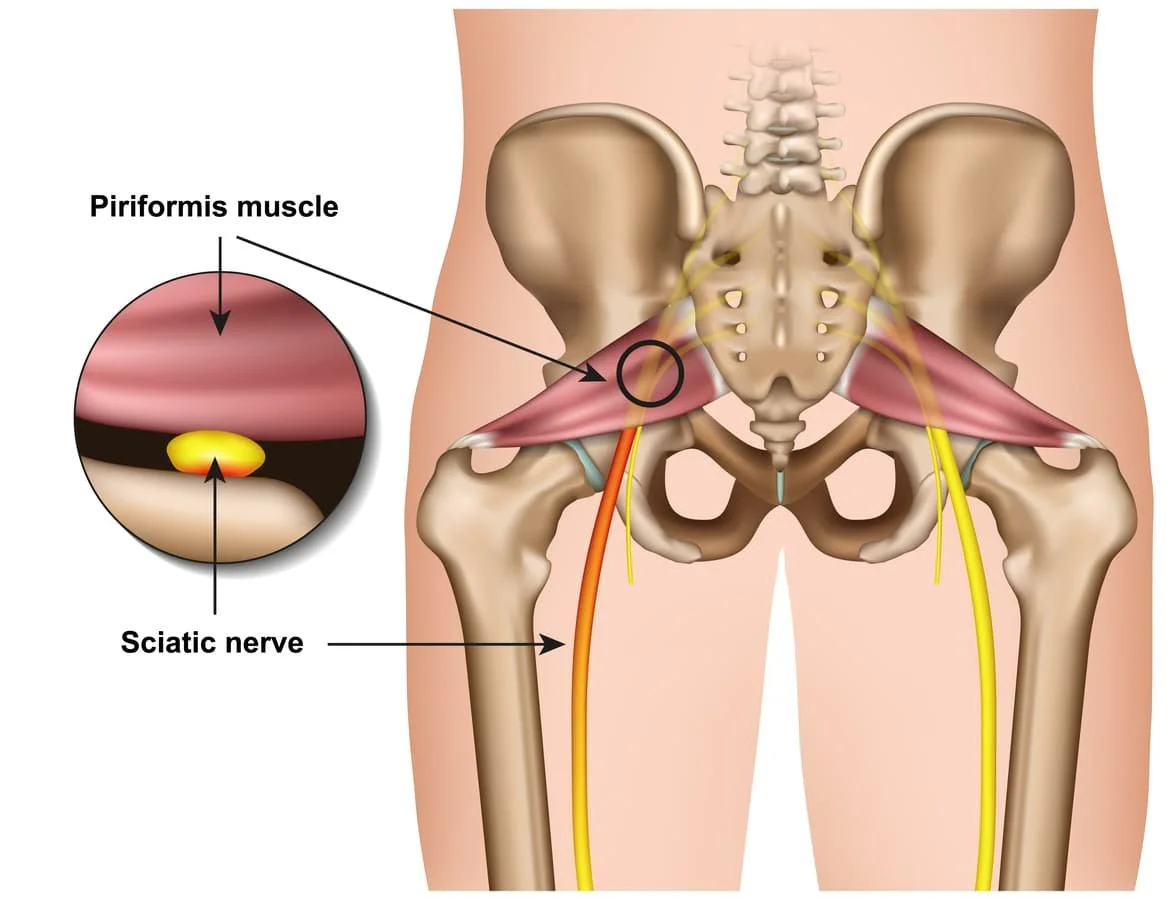Piriformis Syndrome
Piriformis syndrome is a painful neuromuscular condition in which the piriformis muscle spasms and irritates the surrounding sciatic nerve resulting in pain, numbness and tingling in through the buttock and along the back of the leg and into the foot.
Anatomy And Function
The piriformis muscle is located deep within the gluteus maximus where it inserts at the sacrum (part of the pelvis) and attaches to the greater trochanter of the femur (upper part of the thigh bone). The piriformis muscle is involved in stabilizing the hip joint, allows for outward rotation of the hip so the leg and foot can turn out, assists in raising the leg sideways away from the body (abduction) and partial extension of the hip.
Whereas the sciatic nerve is the largest nerve in the body and is formed from the union of five nerve roots from the lower spine. It runs either alongside or through the piriformis muscle, goes down the back of the leg and branches into smaller nerves that end in the feet. This nerve plays a pivotal role in providing sensation for your legs but also helps the muscles to allow for movement of your legs and feet.
Causes Of Piriformis Syndrome
The most common cause of piriformis syndrome is trauma to buttocks resulting in inflammation/muscle spasm of the soft tissue resulting in nerve compression. Other causes can include:
- Post-surgical injury
- Altered mechanics of the lower limb, pelvis or lower back resulting in shortening of the piriformis muscle
- Overuse of the muscle from long distance running or walking or by sitting on hard surfaces
- Piriformis muscle is compensating for the larger gluteal muscles that are not activating when they should
Clinical Presentations Of Pirifomis syndrome
Low back pain
Buttock pain
Pain or numbness down the back of the leg and into the foot
Difficulty walking
Pain with sitting, squatting or standing
Foot on the involved side is flared outwards
Stretching Of The Piriformis Muscle
Hip muscle strengthening
Avoid prolonged sitting
Making frequent stops when driving to stand and stretch
Prevent trauma to the gluteal muscles
Taking a warm bath
Knee bends
Not carrying wallet in back pocket
How Chiropractic Care Can Help
Chiropractic care is one of the least invasive but most effective treatments for piriformis syndrome. By ensuring that the spine is in its proper alignment it takes the pressure off the soft tissues that may be overworking due to the biomechanical changes that have taken place in the spine. This will help the piriformis muscle to relax and take the pressure off the sciatic nerve which may help to alleviate pain.
What To Expect At Your First Chiropractic Visit
An initial Chiropractic exam for back pain will typically have three parts: a consultation, case history, and physical examination. Laboratory analysis and X-ray examination may be performed.
Consultation. The patient meets with the chiropractor and provides a brief synopsis of his or her lower back pain, such as:
Duration and frequency of symptoms
Description of the symptoms (e.g. burning, throbbing)
Areas of pain
What makes the pain feel better (e.g. sitting, stretching)
What makes the pain feel worse (e.g. standing, lifting).
Case history. The chiropractor identifies the area(s) of complaint and the nature of the back pain by asking questions and learning more about different areas of the patient's history, including:
Family history
Dietary habits
Past history of other treatments (chiropractic, osteopathic, medical and other)
Occupational history
Psychosocial history
Other areas to probe, often based on responses to above questions
Physical examination. A chiropractor may utilize a variety of methods to determine the spinal segments that require chiropractic treatments, including but not limited to static and motion palpation techniques determining spinal segments that are hypo mobile (restricted in their movement) or fixated. Depending on the results of the above examination, a chiropractor may use additional diagnostic tests, such as:
X-ray to locate subluxations (the altered position of the vertebra)
A device that detects the temperature of the skin in the paraspinal region to identify spinal areas with a significant temperature variance that requires manipulation.
Chiropractors are trained in a variety of methods to assess the underlying cause of the problem, including:
Evaluation and management services. Chiropractors are trained in examining the joints, bones, muscles and tendons of the spine, head, extremities and other areas of the body with the purpose of noting any misalignment, tenderness, asymmetry, defects or other problems.
Neurologic and other common physical examination procedures. Chiropractors are trained to perform a variety of neurologic tests (nerve root compression/tension, motor strength, coordination, deep tendon and pathological reflexes, etc.) and are skilled in performing orthopedic, cardiovascular and many other common examinations.
Specialised assessment. Chiropractors are trained to assess range of motion, stability, muscle strength, muscle tone and other assessments with the lower back.
Common diagnostic studies. Chiropractors are trained in use of diagnostic studies and tools such as radiography (X-rays), laboratory diagnostics and neurodiagnostics.
References
1. 1.Does Posture affect your learning/confidence/ mood? - Your Body Posture
2.How Your Emotions Affect Your Health – Awareness Act
3.www.mindtools.com/pages/article/Body_Language.htm
4.Completing Our Body's Stress Response Cycle | UK Human Resources (uky.edu)
5.https://www.psychologistworld.com/stress/fight-or-flight-response
6.https://www.hss.edu/article_parasympathetic-nervous-system.asp
7.10 Quick Ways to Activate your Parasympathetic Nervous System – Brain Gardening®
8.The Beginners Guide to Chiropractic - YouTube
9.Chiropractic Can Help With Posture - YouTube
10.Heidi Haavik Research - Neck Pain - YouTube
11. https://www.physio-pedia.com/Piriformis_Syndrome
12. https://www.cedars-sinai.org/health-library/diseases-and-conditions/p/piriformis-syndrome.html
13. https://www.health.harvard.edu/diseases-and-conditions/ask-dr-rob-about-piriformis-syndrome
14. https://cnjournal.biomedcentral.com/articles/10.1186/s41016-020-00189-y
15. https://journals.lww.com/acsm-healthfitness/fulltext/2014/07000/piriformis_syndrome.3.aspx
16. https://www.ninds.nih.gov/Disorders/All-Disorders/Piriformis-Syndrome-Information-Page


